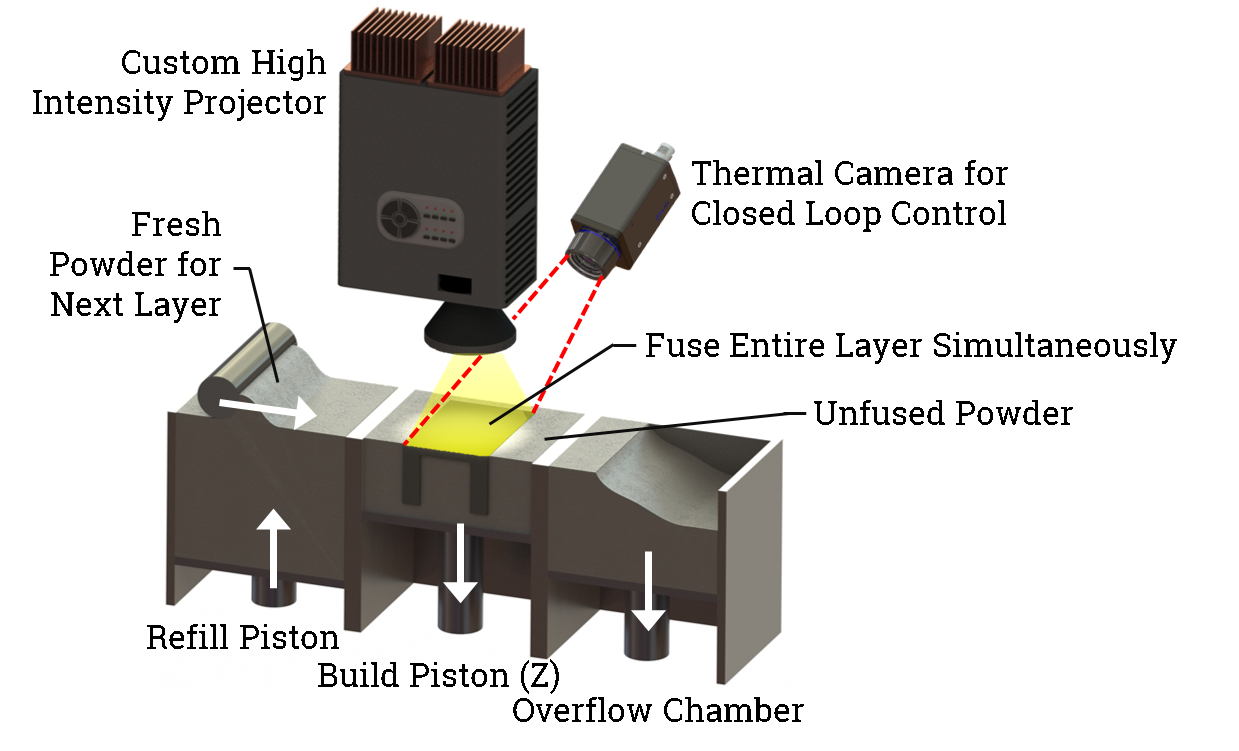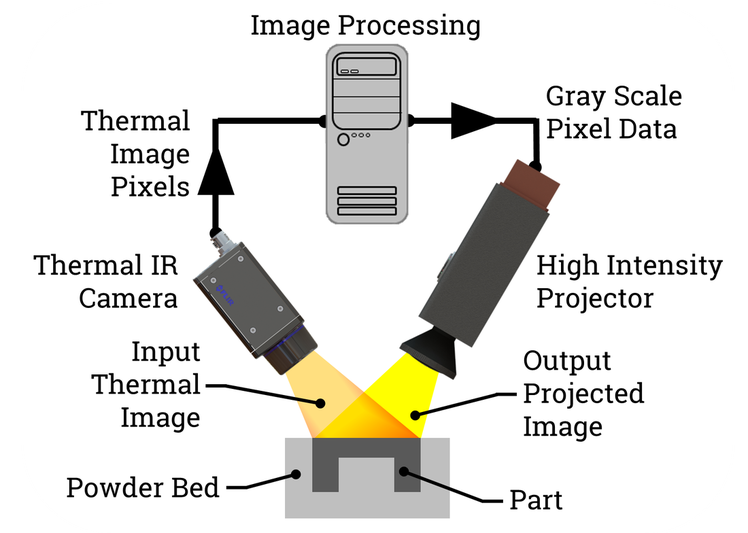3D printer manufacturer Ascend Manufacturing has revealed the inner workings of its novel Large Area Projection Sintering (LAPS) 3D printing method.
In an interview with Founder and CEO of the company Justin Nussbaum, 3D Printing Industry found out more about the closed-loop additive manufacturing technology behind the new method. The powder bed fusion (PBF) technique is described by Nussbaum, as a combination of selective laser sintering (SLS) and maskless projection stereolithography. Using a closed-loop system including thermal cameras, the 3D printer is able to constantly monitor and adjust the temperature of the powder bed, without input from the user. The simplified manufacturing process ensures that the bed is heated evenly and at a constant temperature, which enables whole part layers to be manufactured at one time.
“Our process disconnects the layer time from the overall manufacturing time. As we scale the system up, it still takes the same amount of time to fuse a layer, but we can now fuse a lot more parts in the same amount of time. Our production systems will literally be capable of making hundreds of thousands of parts, in a single day,” said Nussbaum.
Ascend Manufacturing
The manufacturing technique was developed by Nussbaum while studying for his Ph.D. at the University of South Florida. After founding Ascend Manufacturing in 2018, the graduate was awarded $500,000 to commercialize the technology as part of the Innovation Crossroads scheme by Oak Ridge National Laboratory (ORNL). Facilities at ORNL have provided all the advanced testing equipment necessary to progress the technology, with CT scanners, 3D microscopes, and a research team to support its development.
The startup is now looking for additional investment, to make its next step from the laboratory, to commercial production, with the aim of filling what it perceives as a gap in the market for a “middle volume” production service.
“There’s a disparity between ordering ten or one hundred parts and very high volumes. That’s where 3D printing is really starting to shine. What we want to do is help to bridge that gap and make a disconnect between the price and part quantity. So, whether you wanted one part or a million of them, you can have them manufactured for the same price per part.”
Nussbaum credits the “newer players” in 3D printing, for taking a similar approach to medium volume production, such as HP and its Multi Jet Fusion Technology. Nonetheless, he remains adamant that his LAPS system is very different to other SLS-based machines.

Large Area Projection Sintering Technology
The LAPS process involves using a high-intensity projector to cast an image onto the powder bed. Materials are then fused into that shape, allowing the whole layer to be produced at once, and disconnecting the time taken to create a layer from the overall manufacturing time. As the company has experimented with build volume increases and larger beds, layer production times have not increased, but it has allowed more parts to be fused at once.
The LAPS system’s optical and thermal camera not only supervises the process but is also able to control it. During layer formation, the thermal camera is able to monitor the temperature of the bed in real-time, and update the image being sent to the projector so that the whole area is fused at an even temperature. As a result, fewer user inputs are necessary, with only temperature and time parameters required, which acts to reduce the level of expertise necessary to operate the machine.
According to Ascend, other high-speed sintering techniques heat the whole powder bed but at varying temperatures across the bed, which limits the plastics that can be used. The LAPS system, on the other hand, has been compatible with every tested material so far, ranging from low cost to high-performance materials. Parts produced during testing exhibited 100% density with no visible pores and a side wall finish that is comparable to those produced using SLS or MDF 3D printers. The top surfaces of the products were also smooth, with a surface roughness that’s measurable in nanometers.
“The finish is highly smooth, it’s a plastic but it ends up being reflective. That’s given us some advantages, specifically for printed electronics, where if you have a rough surface it makes it difficult.”
A total of $1m has been invested in the project since 2015, with Innovation Crossroads providing $500k in funding through ORNL and an additional $500k being provided by multiple grants from the NSF, State of Tennessee and the University of South Florida. Additional funding is now being sought to take the initial step of becoming a contract manufacturer. In this role, the company would sell services and components such as tools and fixtures, in addition to other end-use components for consumer goods.
Ultimately though, Ascend’s long-term goal, given the enhanced weight-strength ratio exhibited by parts during testing, is to develop components for the aerospace and defense industries. Despite the business disruption caused by Covid-19, the company plans to make revenue by the end of the year, with the aim of beginning to offer services in 2021.

Closed-loop additive manufacturing
Although full closed-loop control has not yet been commercialized in SLS 3D printing, it has been utilized by researchers and companies for other means.
Researchers from the Argonne National Laboratory added an infrared camera, capable of capturing thermal signatures of melted particles at 100,000 frames per second (fps), to a PBF system in September 2018. The device’s addition to the 3D printer reflected a doubling down of the lab’s efforts to enhance the reproducibility of PBF processes.
Chicago-based metal 3D printer manufacturer Sciaky Inc brought closed-loop control to its Electron Beam Additive Manufacturing (EBAM) machines in February 2016. The Interlayer Real-time Imaging & Sensing System, monitored the geometry, mechanical properties, microstructure, and metal chemistry of parts produced.
The nominations for the 2020 3D Printing Industry Awards are now open. Who do you think should make the shortlists for this year’s show? Have your say now.
Subscribe to the 3D Printing Industry newsletter for the latest news in additive manufacturing. You can also stay connected by following us on Twitter and liking us on Facebook.
Looking for a career in additive manufacturing? Visit 3D Printing Jobs for a selection of roles in the industry.
Featured image shows the Oak Ridge National Laboratory, where Ascend’s LAPS technology is being developed. Photo via Ascend Manufacturing.



